Menus
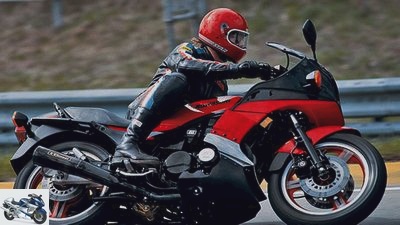
archive
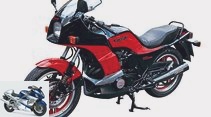
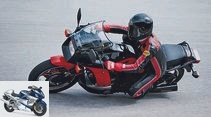
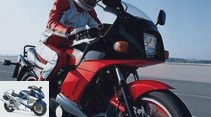
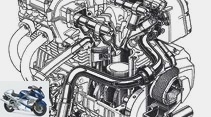
13 photos

1/13
A new feature of the Kawasaki Z 750 Turbo’s speedometer is the charge pressure indicator above the rev counter, which otherwise has no GPZ.
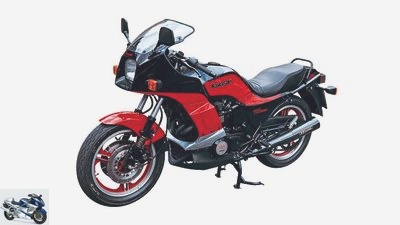
2/13
The Kawasaki Z 750 Turbo was probably the most sophisticated turbo bike of its time.
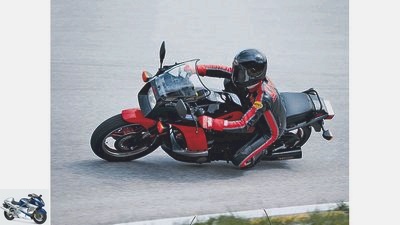
3/13
The fear of a brutal explosion in performance in an inclined position is unfounded: The turbocharger of the Kawasaki Z 750 provides an emphatic but predictable thrust.
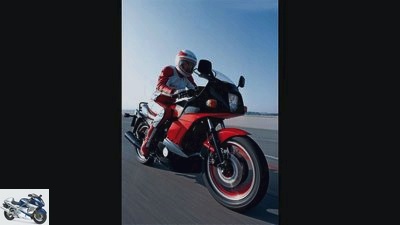
4/13
The thrust of the Kawasaki Z 750 Turbo left you with an unexpected frenzy of speed.
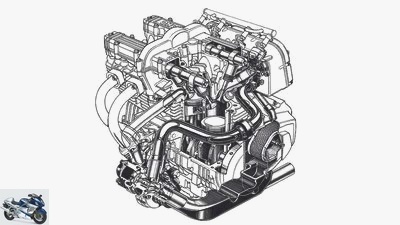
5/13
The engine of the Kawasaki Z 750 Turbo with its 100 HP (112 HP in the open foreign version) paired with the turbocharger ensured unlimited pull forward.
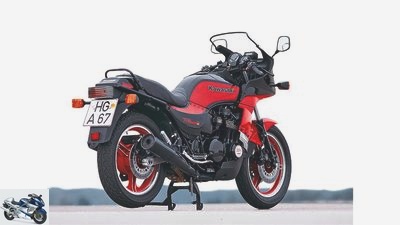
6/13
In contrast to the competition, the Kawasaki Z 750 Turbo does not have an overly futuristic styling.
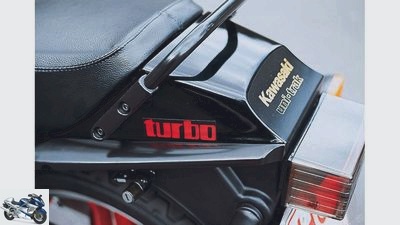
7/13
Discreet lettering reveals that there is no banal GPZ 750 at the start, but the Z 750 Turbo.
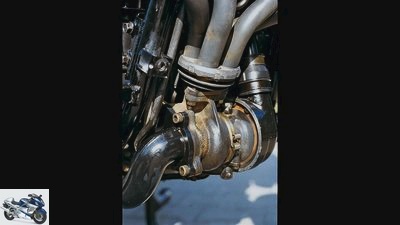
8/13
The Hitachi turbocharger of the Kawaski Z 750 is small and compact, but delivers real superlatives with 200,000 rpm and an exorbitant replacement part price.
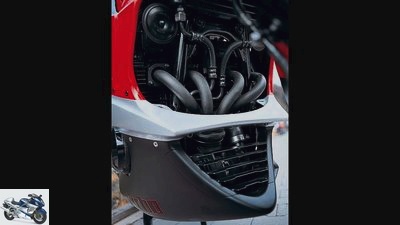
9/13
The turbocharger of the Kawasaki Z 750 Turbo lies in the cooling airstream, well protected behind the fairing keel with aluminum spoiler.
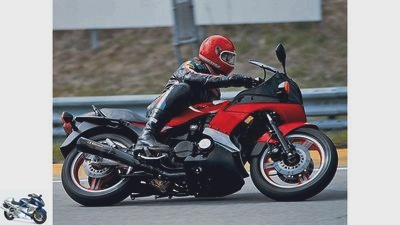
10/13
Passable lean angles are possible with the Kawasaki Z 750, quick changes of lean angle are not possible: With its chassis geometry and 18-inch wheels, the Turbo is stable but not very handy.
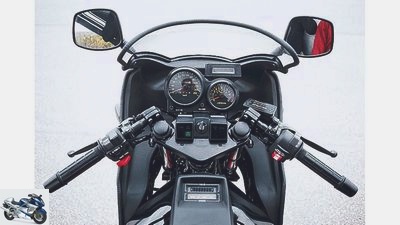
11/13
The cockpit and the tank console with fuel gauge and indicator lights on the Kawasaki Z 750 Turbo are known from other GPZs.
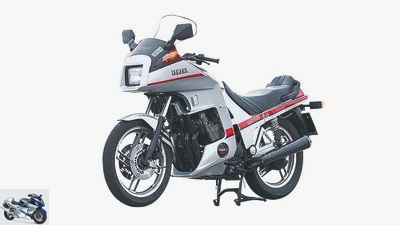
12/13
The 90 hp Yamaha XJ 650 Turbo is much more exotic with its styling.
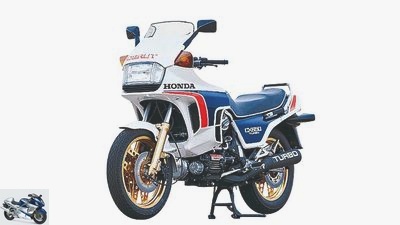
13/13
The Honda CX 650 Turbo with an impressive 100 hp is more futuristic than the Z 750 from Kawasaki.
Final: Kawasaki Z 750 Turbo
MOTORRAD reports on the Kawasaki Z 750 Turbo
There are only a few production motorcycles with turbocharging. And even less successful. The Kawasaki Z 750 Turbo is arguably the most sophisticated and best-selling, and it cast a spell over technology fans and performance freaks in the 1980s. So does the editor Gerhard Eirich.
I discovered them in the bulky waste. The Z 750 Turbo was advertised in the newspaper for free classified ads with the bizarre, misleading name. Even while reading the magic word turbo spontaneously triggered mental salivation and awakened a lot of associations: barely controllable performance, a killer kick in the back with full boost pressure, flashes of flames from the exhaust, at night spectacularly red-hot turbochargers. The abbreviation was pronounced with awe at regulars’ tables, and those who knew how to tame a turbo-charged vehicle were secretly considered real men. The mind dared a tentative attempt to defend itself against the violently burgeoning, overpowering will to buy, but the fight was hopeless. The word "malfunction" After all, it was easy to ignore the term turbocharger.
Buy complete article
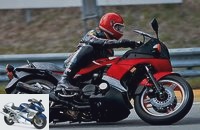
Final: Kawasaki Z 750 Turbo
MOTORRAD reports on the Kawasaki Z 750 Turbo
Kawasaki borrowed from the GPZ 1100 and tuned to the 750 engine.
The basic features of the air-cooled four-cylinder came from the half-faired GPZ 750 Uni Track, but had been modified and equipped for the higher loads: the cylinder head of the Z 650 had narrower ducts, tamer control times and ensured better heat dissipation than the original head reinforced pistons and the compression reduced from 9.5 to 7.8: 1 should help to withstand the boost pressure of a maximum of 0.73 bar over the long term. The open foreign version of the two-valve engine produced 112 hp, officially only 100 hp in Germany. The spoiler was another chip in the injection control unit. And how many of the 100 horses would be left without loader support? I completed the first few kilometers home with a certain reluctance. After all, the first few kilometers of winding country roads turned out to be quite unusual in view of the elongated sitting posture, bent over the narrow, strongly cranked handlebars and the top-heavy, stubborn driving behavior. The good was certainly not particularly light and easy to handle with its 254 kilograms, flat fork and even more caster than the GPZ 1100. But noticeably stronger than my Yamaha XJ 550 with its 50 hp that I had ridden up to then. With the mounted accessory roaring pipes, however, it is also significantly louder. Fortunately, the original mufflers were included. Unfortunately, the Kawa did not have valid TÜV and approved tires in the ridiculously narrow original sizes, which should give me discussions at the TÜV ("You won’t get the 150 in the back from me").
A turbo motorcycle, but with a broken turbo charger? The roommates of my student flat shares didn’t save with stupid comments. But they should soon fall silent, the scoffers and bad guys. The luck of the brave was on my side: barely two weeks later, after scouring thousands of classifieds, I actually discovered the needle in the haystack: an accident machine approved for cannibalization. "Turbocharger? Yes, I think it’s still there. The box belongs to my brother, he’s on vacation." I had to react quickly. And stay cool. In a garage, leaning against the wall, stood the skeleton of the crashed Turbo. The short visual inspection revealed no damage to the loader. The price? "What would you pay?" Damn it, don’t gamble too high now. If I offer insolently little, he chases me from the yard. I risk it anyway. "Hmm, it’s not very fresh anymore. 150 marks?" "Recovered." I staggered blissfully back to my car.
archive
The charger of the Kawasaki Z 750 Tubro lies in the cooling airstream, well protected behind the fairing keel with an aluminum spoiler.
An hour later I peeled off my ailing turbo sweetheart to plant the loader that saved her and breathe new life back into it. But what was that? I rubbed my eyes: the connection between the charger and the intake tract was broken. A clamp had loosened, the connections had slipped and the turbo blew into nothing. Is that supposed to be the whole joke? Put them together, tighten the clamp, on to the test drive around the block. It was like Christmas, Easter and a birthday all in one day: the display in the cockpit indicated boost pressure, the popometer showed previously unknown thrust from medium engine speeds – the turbocharger reported back to duty. The 47 millimeter measuring compressor wheel of the Hitachi charger should no longer rotate for free at 200,000 rpm, and the power-enhancing pressure that builds up from around 5000 rpm engine speed no longer flows unused into the open, but only as planned after reaching the maximum pressure of 0 , 73 bar hissing into the void via wastegate (pressure relief valve).
A sunny June day, full power on board, almost free motorway – now it was time to go. Man or coward? Carefully warm up, stroll along in the right lane at 120, the end of the 100 km / h limit in sight. An S-Class is shooting up from behind in the left lane, a truck with 80 items is parked in front of me, well: shift down, load, pull out and full throttle. The turbine forcefully presses air into the four-cylinder, the three-quarter-liter boiler almost seems to burst, the turbo angrily pulls my arms out. The engine revs up in a flash. Switch, head down, dive in and let the gas stand. The Benz has long since disappeared from the rearview mirror. A previously unknown intoxication attacks me – what a surge! Let go, speedometer 245 – crap, a left-hand junk dealer brings me back to the ground. There would certainly have been more.
It may well be that memories are transfigured. From today’s perspective, the Turbo is simply a strong bike. No less, but no more. The onset of thrust is cool, but not martial or uncontrollable. Horrifying usages also belong in the realm of fairy tales and legends. With six liters / 100 km, the Kawa is normal to drive, only with full throttle it is sometimes up to nine liters. We only danced one summer, Turbo and me. Then I was driven to new shores. Other manufacturers also have beautiful daughters. But of all exiles, I mourn the red and black lady the most. I’ll be scouring the classifieds just for fun.
Technical specifications
archive
The Hitachi turbocharger of the Kawaski Z 750 is small and compact, but delivers real superlatives with 200,000 rpm and an exorbitant replacement part price.
Engine:
Four-cylinder four-stroke in-line engine, two valves per combustion chamber, controlled by bucket tappets, bore x stroke 66 x 54 millimeters, 738 cm3, 74 kW (100 hp) at 9000 rpm, 99 Nm at 6500 rpm, injection, electric starter, oil bath clutch , Five-speed gearbox, chain drive.
Landing gear:
Double loop tubular frame, telescopic fork at the front, aluminum two-armed swing arm at the rear, air-assisted central spring strut, double disc brake at the front with floating caliper, Ø 280 mm, rear disc brake with floating caliper, Ø 270 mm, cast wheels, 110/90 V 18 and 130/80 V 18 tires.
Measurements and weight:
Wheelbase 1490 mm, caster 117 mm, seat height 770 mm, weight with a full tank 254 kg, tank capacity 18 liters, top speed 225 km / h, price 11190 Mark (1983)
Related articles
-
Comparison test: Honda CX 500-650 Turbo, Kawasaki Z 750 Turbo, Suzuki XN 85, Yamaha XJ 650 Turbo
Jahn 21 pictures Jahn 1/21 The preload of the central spring strut of the Suzuki can be easily adjusted. Jahn 2/21 Tight corners and fast …
-
van de Kuilen 10 pictures van de Kuilen 1/10 Kawasaki Z 1300 with turbo charger and 180 hp. van de Kuilen 2/10 top speed? Doesn’t matter to Richard Fluttert. 180 hp …
-
Final: 25 years of the Kawasaki GPZ 900 R
Artist Final: 25 years of the Kawasaki GPZ 900 R Fire under the bum It opened a new era: strong, fast, stable. The GPZ 900 R, Kawasaki’s first ninja with…
-
The last of its kind: the cult bike Kawasaki Z 750 Turbo
Jahn 27 pictures Jahn 1/27 The Kawasaki Z 750 Turbo showed that turbochargers are not automatic for uncontrollable performance, low durability and high …
-
Endurance test final balance of the Kawasaki ZX-10R
Bilski endurance test final balance sheet Kawasaki ZX-10R Too good to strip After 50,000 kilometers it is opened, looked inside and measured. So are the …
-
Kawasaki 25 pictures 1/25 The retro bikes Harley-Davidson Sportster 883 Roadster, Kawasaki W 800 Special Edition, Moto Guzzi V7 Special and …
-
Volker Rost 14 pictures Volker Rost 1/14 roaring pipe. Infernal sound escapes from the elbow-thick elbow – uninsulated. The once sitting in front of the engine …
-
Acceleration test Kawasaki Ninja H2 and Kawasaki Ninja H2R
fact 28 pictures fact 1/28 They cause a stir – not least thanks to the built-in compressor. fact 2/28 “silencer” is not quite the right one …
-
On the move with Sauerborn-Munch TTS 1200 Turbo and support BMW K 100 RS Turbo
Jacek Bilski 21 pictures Jacek Bilski 1/21 In the early 80s the Japanese thought that turbochargers would go best with small engines. Two …
-
Driving report Turbo Harley Today a king A Harley with well over 100 hp – that’s the icing on the cake. Let’s take a Road King. It weighs a good six and…